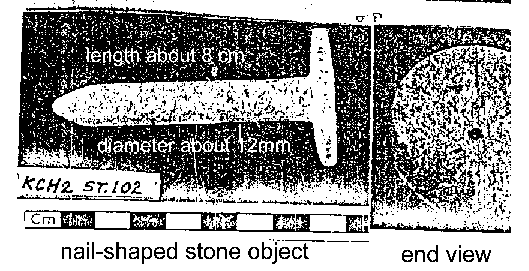The accompanying rather poor photograph is of an object found in a Neolithic site in Lopburi Province in Thailand. It is from a dig carried out by an Anglo-Thai archaeological expedition in 1965, and in which Dr Helmut Loofs-Wissowa of the Australian National University took a major part. The site is dated from about 1500 BCE.
It is of stone and has been described as a “nail-shaped object”; it is of circular section, about 8 cm long, with a shank diameter of about 1.2 cm; the head is about 4 cm in diameter with radial lines inscribed in the face.
Several such items were found at the site in association with human skeletons, usually located near the head.
What was it for? A couple of theories have emerged.
Dr. Loofs Wissowa sees it as a form of ear decoration, intended to project through the lobe, with the larger part to the front. There are modern forms of such ear plugs made of ivory, if smaller. If it were such a thing, its weight on the ear would be considerable.
Alternatively, I wonder if it is a ritual item used for the defloration of girls of marriageable age. I note, for example, the mention in Zhou Daguan , from his description of urban life in Angkor in 1295, of the ritual defloration of young girls by Buddhist or Taoist monks.
Since we have no idea of the daily life of a community in Central Thailand of four thousand years ago, it is difficult to imagine how affairs were organised with only the evidence of a few skeletons, a few pots and some other detritus.
Can any New Mandala readers help in identifying it, and its uses.
 Facebook
Facebook  Twitter
Twitter  Soundcloud
Soundcloud  Youtube
Youtube  Rss
Rss 